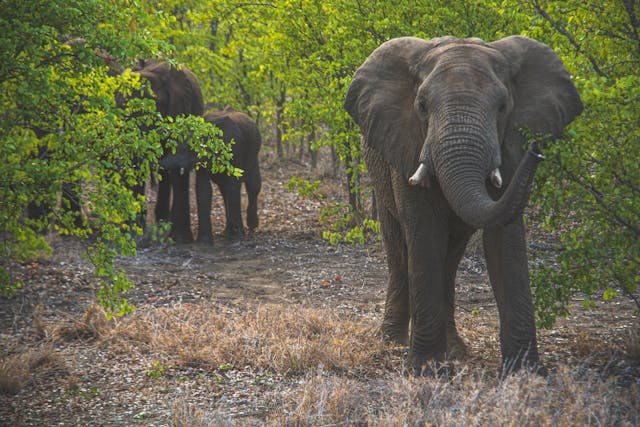
How good is an elephant’s sense of smell? Elephant’s have a better sense of smell than any other animal on Earth.
We know that our sense of smell is pretty basic when we compare it to a lot of other animals, but that makes sense because we have evolved for more of our brain to be involved with sight and hearing (language) than with smell. Our sense of smell is obviously important to us (we can’t taste anything without it) but it is not our most important sense. A lot of animals rely on scent a lot more than they do their other senses. Dogs don’t have great eyesight and they can’t see as many colors as we can. We can see (hopefully) if an animal is hiding in a bush, but they probably cannot. They can smell it though. Their sense of smell is directional because they can compare the difference in the strength of scents coming in through each nostril. We often rely on dogs for their sense of smell, but they pale when compared with the olfactory strength of an elephant.
Elephants have such a powerful sense of smell that they are able to smell a water source from 20 km away. They cannot smell the water itself because water doesn’t have an odor, but they can smell the plants that decay in the water. They have probably evolved this ability because they are enormous animals and they need to drink between 100 and 200 liters of water a day. In the dry period, water can be hard to come by, so they have evolved their ability to smell it from so far away. They can also smell food from a long way away, as well. They can smell different kinds of plants and know which ones they would prefer to eat. They can smell predators from a long way off, although adult elephants don’t really have any major predators. Lions might try to kill a young or a sick elephant, but they would stand no chance against an adult elephant. Another use of their sense of smell is being able to smell a potential mate.
Two examples of elephants’ extraordinary sense of smell have been tested in experiments. The first is that elephants were observed avoiding a minefield. It turned out that they were able to smell the TNT that was in the mines, buried under the ground. In tests, elephants were almost 100% accurate in detecting TNT. They are also able to smell quantities. Elephants were presented with locked buckets of different quantities of sunflower seeds. Just by smelling the buckets, they were able to choose the bucket with the most sunflower seeds up to 80% of the time.
So, how are elephants able to smell so well? It comes down to the number of olfactory receptors they have and the way they can control their nose. The number of olfactory receptors we have and the variety of chemicals that they are able to detect is dictated by the number of olfactory receptor genes that we have. Humans have 396, which is more than some of the other apes, but not very high. Rabbits beat us easily because they have 768. Dogs have 811, which makes their sense of smell far better than ours, but they are left in the dirt by mice, which have 1130, and rats, which have 1207. However, no animal compares to the elephant, which has 1948 olfactory receptor genes.
The way elephants can manipulate their trunks plays a big part in how they can smell so much as well. If you smell an apple pie cooking somewhere, but you don’t know where, you might turn your head to the left and right, trying to work out where the scent is strongest. Many animals have the ability to turn their ears to capture sound, but only elephants have the ability to turn their noses to capture scents. Their trunks are as dexterous as an arm and they can move them in any direction to suck up scents. Then, the inside of the trunk is lined with olfactory receptors, which can tell them what they are smelling. Elephants have seven curls of bone inside their trunk that direct the chemicals in the scent over the millions of olfactory receptor cells, spreading them out over a larger surface area to get more information from them. The strength of the scent on the left or the right side will tell them where the scent is coming from and probably roughly how far away it is. They can also use their trunks to pick up things off the floor and touch them to the rough of their mouth, where there are even more olfactory receptors. And this is what I learned today.
Photo by Boris Ulzibat: https://www.pexels.com/photo/an-elephant-on-the-field-3378990/
Sources
https://theconversation.com/how-african-elephants-amazing-sense-of-smell-could-save-lives-85626
https://phys.org/news/2014-07-elephants-superior.html
https://www.nature.com/articles/s42003-023-04945-5
https://www.sabisabi.com/discover/topics/how-do-elephants-find-water-dry-times
https://www.u-tokyo.ac.jp/focus/en/articles/a_00292.html
https://www.pbs.org/wgbh/nova/article/elephants-smell-quantity

Pingback: #1084 Why does the corpse plant smell so bad?